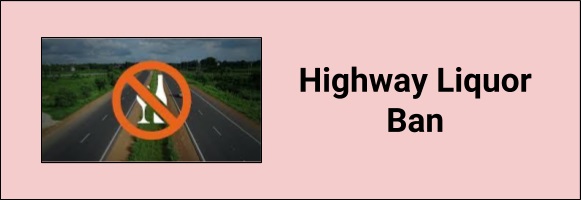(HOT) UPSC Current Affairs 2025 PDF
NEW! The Gist (NOV-2025) | E-BOOKS
Highway Liquor Prohibition : Important Topics for UPSC Exams

Highway Liquor Prohibition : Important Topics for UPSC Exams
Why in News?
In its recent judgement, the Supreme Court gave the State governments the discretion to decide, on facts, whether areas proximate to municipal pockets or areas covered by local self-governing bodies should be exempted from the court’s December 2016 judgement on prohibition on sale of liquor within 500 metres along the highways.
Supreme Court Judgement
-
In its December 2016 Judgement, the Supreme Court mandated the States and UTs to shut down all liquor vends like Bars, restaurants, shops etc. which are situated within 500 meters of the outer edge of National/ State Highways and the ban extended to highways passing through city/ town. Along with it the states were barred from granting the fresh licenses.
-
The ban order was based on a Supreme Court judgment on the petition in the State of Tamil Nadu vs K. Balu case (15 December 2016) and the Supreme Court had pointed out that the sale and consumption of alcohol was not a fundamental right enshrined in the Constitution.
-
The court exempted municipal areas from the prohibition on its another July 11, 2017 judgement and mentioned that ban mainly targeted busy national and State highways inter-connecting cities, towns and villages along.
Analysis
-
The main aim of the liquor prohibition, imposed in December 2016 judgment, was to prevent drunk driving along the National and State highways and SC had further mentioned that the order does not prohibit licensed establishments within municipal areas.
-
The July 11 order led to more confusion and states like Tamil Nadu sought for more clarification, on whether panchayats would also come under the definition of “municipal areas” mentioned in the order and further Tamil Nadu’s point was, “municipal areas” were not intended to exclude areas within the jurisdiction of local self-governing bodies and the States reasoned that in future, these panchayats might be developed in a manner similar to municipalities, or some of them might be geographically proximate to an urban agglomeration.
-
In a response to the objection laid on the July 11 order SC said that it is left to the States to take a decision after examining whether an area covered by a local self-governing body is proximate to a municipal agglomeration or is sufficiently developed and in deciding whether the principle which has been set down in the July order should be extended to a local self-governing body, the State governments would take recourse to all relevant circumstances, including the nature and extent of development in the area and the object underlying the direction prohibiting the sale of liquor on highways.
Buy Printed Complete Study Materials for UPSC IAS PRELIMS Exam
Online Crash Course for UPSC PRE Exam
Why such a ban?
-
A PIL petition filed by NGO Arrive Safe in the Supreme Court, said nearly 1.42 lakh people were killed in road accidents every year, mainly owing to drunk driving.
-
At a meeting in January 2004, the National Road Safety Council, which was established under the Motor Vehicles Act, 1988, had concluded that liquor shops should not be given licences along the National Highways and this was followed up by a Road Transport and Highways Ministry’s circular to all State governments, advising them to remove liquor shops situated along the National Highways and not to issue fresh licences in 2011, 2013 and 2014.
-
The court relied upon the “alarming” statistics on road accidents and remarked that human life is precious. During 2015, 5.01 lakh people were injured and 1.46 lakh people killed in road accidents, as per official data compiled by the Road Transport and Highways Ministry. Although driving under the influence of alcohol or drugs accounted for 3.3% of the total road accidents and 4.6% of the total deaths, the court contended that over-speeding, the prime reason for accidents, could also occur owing to drunk driving.
-
The advisory drew attention to the parliamentary mandate of zero tolerance of driving under the influence of alcohol.
-
The Supreme Court also highlighted the Union government’s policy titled ‘Model Policy/taxation/act/rules for alcoholic beverages and alcohol’ issued a decade ago, which advocated a ban on liquor vends situated 220 metres from the middle of the State or National Highways.
Impact of the ban
-
A few States argued that the ruling would result in revenue loss.
-
According to estimates by the Federation of Hotel and Restaurant Associations of India (FHRAI), the ban will lead to a loss of ₹2 lakh crore to the exchequer and ₹20,000 crore to the industry. It has estimated that nearly 1 lakh establishments will face the threat of closure.
Other issues involved
-
In order to escape from the ban, the States are taking steps to convert their highways into local roads i.e. states like Rajasthan, Maharashtra, Himachal Pradesh, Uttarakhand, West Bengal and the Union Territory of Chandigarh have de-notified hundreds of kilometres. However, the National Highways can be re-classified into local roads only by the Road, Transport and Highways Ministry.
As Consumption of alcohol is it purely personal choice so judgement by Judiciary in this respect is not a proper step to take and it is further encroachment in the field of legislative. The fundamental principle of Separation of power should be taken care of.
MODEL QUESTIONS
Q. Analyse the Liquor prohibition ban imposed by judiciary.Discuss how effective are such kind of bans?
Q. Judiciary has imposed prohibition on sale of liquor along the highways in December 2016. What is the distance stipulated for the same?
A. 100 Meter
B. 200 Meter
C. 300 Meter
D .500 Meter
Answer- D.

